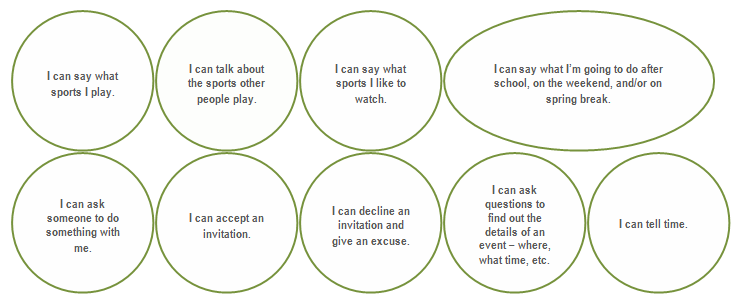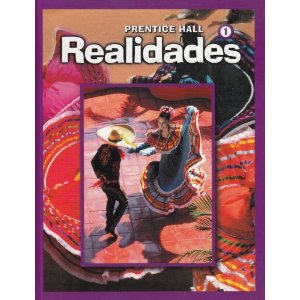Sara-Elizabeth Cottrell mentioned me in a post she wrote about textbooks, so I thought I’d write about how I use Realidades, and what strategies help me incorporate CI and keep the focus on communicative goals. Here’s an overview of what one of my “textbook units” looks like.
Start with I can goals. This can be on a stamp sheet that you give to students, or just in your lesson plan book. The act of writing out communicative goals and referring back to them throughout a unit really helps me keep my eye on the bigger goal, without falling into old habits of marching through the textbook.
Chapter 4b vocabulary covers sports and a couple of other leisure activities. The focus is pretty communicative – making, accepting, and declining inviations, with ir+a+infinitive as the grammar goal. Here is how I fleshed out the goals:

Use what you can from the book.
Although the goals, the grammar, and vocabulary all came from the book, I taught mostly with my own materials. I find the readings in the book too complicated – how do those dialogues count as input if they’re incomprehensible?? I used one or two of the partner dialogues, with extra modeling and scaffolding. I did like several of the listening activities and used those, as I couldn’t find authentic audio that fit my goals (I read the audio script aloud as we do not have the audio CDs. This also allows me to adapt the input to what I want it to be). The workbook pages I ignored, as they all seemed like busy work.
Add CI, #authres and your creativity as needed
Sports were easy to teach – they’re all cognates. To introduce, I showed a slideshow with different sports, we discussed in Spanish who played each one (famous athletes and people in the class), and they filled out a graphic organizer, writing each sport under Me gusta jugar, Me gusta mirar, or No me gusta. We also did a speaking activity where they asked ¿Juegas _______?. For the invitation language, I felt like the input in the book was inadequate, so I designed a reading and a few communicative activities to practice (You could also model very easily through a story). Time was a quick review, again, primarily with my own materials (reused this activity) – we worked on it back in August or September, but I know a lot of them struggled with it, so I felt it merited re-teaching. As for the future tense, I taught it pretty traditionally with an explanation in English, with a quick reference to their all-time favorite song, Vivir mi vida. I will probably need to re-teach when we go back to school next week after spring break, with more modeling (INPUT!) in the TL. As I listen to stamps and grade quizzes I notice what goals students struggle with, and then go back and re-teach (provide more input!) the topics they need more practice on.
Confession: I teach more grammar than I would like because I want to get along with my department.
I don’t believe level 1 students need to understand all the forms of every stem changing verb, nor do I think teaching a chart means that they can use those verbs in a communicative setting. However, I do know that those grammar topics are important to the rest of the teachers in my department, that there are expectations about what level 1 students can do, and that there’s a good chance most of my students won’t have me for Spanish 2. While I do advocate for curriculum changes, I am also a team player, and I want my students to be well-prepared for Spanish 2, no matter who their teacher is. The balance I’ve found is reducing the number of verbs I teach, practicing with an appropriate novice-level communicative goal, but still showing, explaining, and using verb charts. So for this chapter, I taught the full conjugation of jugar, querer, and poder, and yes, I quizzed them on it, but we also focused on the goals of I can talk about the sports I and my friends play ( verbs Juego, ¿Juegas?, Juega, Jugamos, Juegan), and I can ask someone to do something with me (verbs ¿Puedes…? ¿Quieres…?), and I can accept and decline invitations (Sí, quiero ir! No, no puedo, estoy enfermo…).
TL;DR
My department-mandate textbook is still just a resource. Use what you can from the book, throw out what you don’t like, and enrich and supplement! Teach what your students need, not what the textbooks dictates.

found your post while looking for 4B!
I feel like I have to use all of the materials from the texts because 1) I don’t have time to reinvent the wheel with 6 different preps (including a core class) and 12 classes; 2) this is only my third year with the Realidades textbook so I’m learning what is valuable and not valuable in the tb resources
I agree the reading is not comprehensible! Want more input for my students, so I use the audio and video activities. I wish there were more reading materials. The practice work is fine as long as it is balanced with input!
Thank you for this. Do you have the 4a I Can Statements for Realidades?